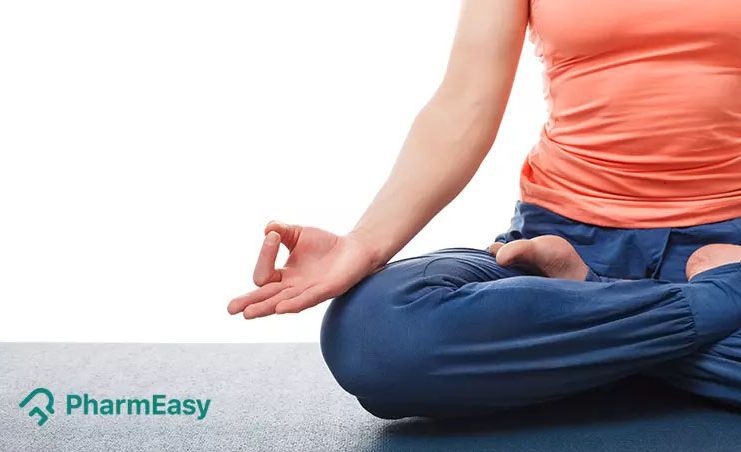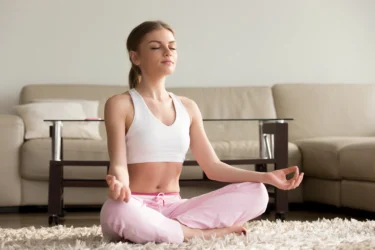Benefits of Chin Mudra and How to Do it By Dr. Ankit Sankhe
By Dr. Ankit Sankhe +2 more

Get,

to manage your symptom
Get your,


4 Cr+ families
benefitted

OTP sent to 9988776655



You’ve successfully subscribed to receive
doctor-approved tips on
Whatsapp

Get ready to feel your best.

Hi There,
Download the PharmEasy App now!!


Register to Avail the Offer
Send OTPBy continuing, you agree with our Privacy Policy and Terms and Conditions

Hi There,
Sign up on PharmEasy now!!
Trusted by 4 crore+ families

OTP sent to 9988776655



You have unlocked 25% off on medicines




Code: NU25
By Dr. Ankit Sankhe +2 more
Table of Contents
Did you know a Google Books search of ‘yoga’ retrieved ‘about 8,850,000’ hits in 1.6 seconds? Numerous books have been written on yoga. In addition, there is an end number of data related to yoga available online in online books, web pages, blogs, youtube videos, and articles. The ‘Upanishads’, ‘Bhagvada Gita’, and ‘The Yoga Sutras of Patanjali’ are among the oldest texts that mention yoga. Yoga includes various techniques like physical postures (asana), breathing techniques (pranayama), mudra (gestures), meditation (dharana, dhyana and samadhi), kriya (yoga of awareness and action) and chanting (mantra)1. Mudra are gestures of positions, usually of hands. It locks and guides the flow of energy in the body2. Let us look at the health benefits of one such mudra, the chin mudra.
The practice of mudras engages the body and the mind, which may have several benefits for the body. The word ‘chin’ means consciousness and mudra means gesture; therefore, chin mudra translates to gesture of consciousness in English. It is believed that the practice of chin mudra may instill wisdom and spiritual enlightenment in an individual. Chin mudra is often combined with asanas (postures) and pranayamas (breathing techniques) like Nadi Shodhana and Ujjayi Pranayama2.

Did You Know?
Some of the interesting facts associated with chin mudra are:
You can do the chin mudra in the following way:
Chin mudra is derived from two words; chin means consciousness and mudra means gesture. As it is easier to practice, chin mudra can be performed in all types of meditation. Therefore, if you are a beginner in the world of yoga and meditation, you can start with chin mudra and proceed towards excellence8.
Dr. Siddharth Gupta, B.A.M.S, M.D (Ayu)
Some of the potential benefits of chin mudra are as follows:

A study3 by Chadayan N. et al. in 2020 showed that practicing a yoga protocol that includes chin mudra might be beneficial to lower blood pressure. However, more research is yet to be done to confirm if chin mudra may be beneficial for lowering blood pressure. Therefore, you must consult your doctor for abnormal blood pressure instead of self-medicating.

A recent study4 by Kumar et al. in 2022 showed that regular yoga practice, including chin mudra, may be beneficial for boosting immunity. This may further be beneficial for infections like covid-19. However; more studies are required to check if chin mudra may boost the immune system. Therefore, you must work on building your immunity regularly and not solely rely on yoga.

A study5 conducted by Narahari et al. in 2016 showed that practicing yoga protocol, including chin mudra, may be beneficial for people with lymphedema due to breast cancer. Lymphedema is swelling in the body due to the buildup of a fluid called lymph. The result suggested that the yoga protocol may reduce fibrosis (thickening and scarring of tissues) and the buildup of lymph. However, further studies are required to check if chin mudra may be beneficial for cancer. Cancer is a dangerous disease; you must take proper treatment instead of self-medicating.

A study6 by Jasti N et al. in 2020 showed that practicing a yoga protocol, including chin mudra, may reduce stress. Additionally, chin mudra may also help to manage depression. This may be due to the ability of chin mudra to stimulate the root chakra. The root chakra refers to the driving force that gives us energy. Chin mudra may help to relax the body and mind, bringing calmness and easing tension2. However, further studies are required to check if chin mudra may be beneficial in managing stress and depression. Therefore, you must consult your doctor if you have high stress levels or symptoms of depression.

Chin mudra may help increase focus and concentration. It may balance the air element and regulate the energy flow in the body; therefore, it may stimulate the brain and empower the mind2. However, more research is required to check if chin mudra can improve concentration.

Practicing chin mudra regularly may stimulate the pituitary gland and the nervous system. The pituitary gland is a pea-shaped gland that controls the other endocrine glands. Chin mudra may help stimulate the pituitary gland and the nervous system by balancing the air element in the body2. However, further studies are required to check if chin mudra can stimulate the pituitary gland and the nervous. Therefore, you must consult your doctor if you experience any symptoms related to hormonal or nervous system disorders.
There are various types of pranayama, i.e., Adham, Madhyam, Adhyam, and Mahat yoga pranayama. All these types of pranayama will help you open up your lung capacity. During Adham pranayama, chin mudra is commonly practised yoga mudra as it might help in controlling the lower parts of the lung7.
Dr. Rajeev Singh, BAMS

Chin mudra may be beneficial for insomnia and other sleeping disorders due to its ability to balance the air element in the body2. However, further studies are required to confirm if chin mudra may be beneficial for sleep disorders. Therefore, you must consult your doctor if you are experiencing any sleeping disorders instead of self-medicating.
Yoga practice may help develop the mind and body; however, it is still not an alternative to modern medicine. Therefore, you must not rely on yoga alone to treat any condition. Instead, please consult a qualified doctor who will be able to assess your situation correctly and advise accordingly. Moreover, it is necessary to practice and learn yoga under the supervision of a trained yoga teacher to avoid any injuries.
There were no associated risks or contraindications that have been investigated or reported as yet. However, it is essential to take necessary precautions before performing chin mudra. You must sit straight with your hands on your knees and palm facing upwards. Your middle, ring and little finger must be adequately stretched. You must be extra cautious if you have heart disease. Pregnant and lactating mothers should be careful too. It is best to perform chin mudra under professional guidance.
The word ‘chin’ means consciousness and mudra means gesture; therefore, chin mudra translates to gesture of consciousness in English. It is believed that the practice of chin mudra may instill wisdom and spiritual enlightenment in an individual. Chin mudra may help to boost the immune system, regulate blood pressure, improve concentration and manage stress and depression. It may also protect against cancer and help in the case of insomnia. Additionally, chin mudra may stimulate the nervous system and pituitary gland. However, yoga is still not an alternative to modern medicine. People with pre-existing diseases, pregnant and lactating mothers must be cautious before performing chin mudra. You must practice chin mudra under the guidance of a professional.
Chin mudra may help to boost the immune system, regulate blood pressure, improve concentration and manage stress and depression. It may also protect against cancer and help in the case of insomnia. Additionally, chin mudra may stimulate the nervous system and pituitary gland. However, yoga is still not an alternative to modern medicine.
Sit in a comfortable position. Keep your back straight and shoulders relaxed. Make sure your head and chest are held high. Place your hands on your knees with your palms facing upwards, and touch the tip of your thumb with the tip of your index finger. Let the middle, ring and little finger be extended. Do this step with both hands. Close your eyes and concentrate on your breathing. You can chant mantras while performing this mudra for a better outcome. You can practice chin mudra three times for about 5-15 minutes each, up to 45 minutes daily2.
Chin mudra is often combined with pranayamas (breathing techniques) like Nadi Shodhana and Ujjayi Pranayama2.
Yes, chin mudra may be beneficial for insomnia and other sleeping disorders due to its ability to balance the air element in the body2. However, you must consult your doctor if you are experiencing any sleeping disorders instead of self-medicating.
Chin mudra may help to improve concentration and manage stress and depression. Chin mudra may also help to relax the body and mind, bringing calmness and easing tension. This may be due to its ability to stimulate the root chakra. The root chakra is the driving force that gives us energy2. However, you must consult your doctor if your mental well-being is hampered.
Disclaimer: The information provided here is for educational/awareness purposes only and is not intended to be a substitute for medical treatment by a healthcare professional and should not be relied upon to diagnose or treat any medical condition. The reader should consult a registered medical practitioner to determine the appropriateness of the information and before consuming any medication. PharmEasy does not provide any guarantee or warranty (express or implied) regarding the accuracy, adequacy, completeness, legality, reliability or usefulness of the information; and disclaims any liability arising thereof.
Links and product recommendations in the information provided here are advertisements of third-party products available on the website. PharmEasy does not make any representation on the accuracy or suitability of such products/services. Advertisements do not influence the editorial decisions or content. The information in this blog is subject to change without notice. The authors and administrators reserve the right to modify, add, or remove content without notification. It is your responsibility to review this disclaimer regularly for any changes.
Comments

Leave your comment...
You may also like
Comments